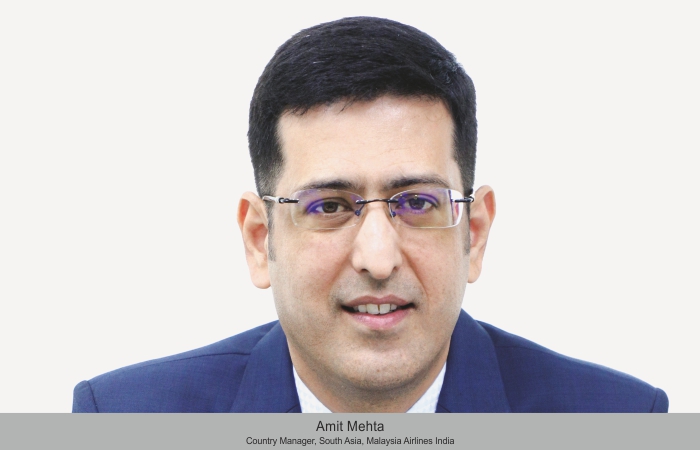Malaysia Airlines is on track to return to the pre-pandemic financial performance by Q4 2023, shares Amit Mehta, Country Manager- South Asia, Malaysia Airlines India. He also discusses the airline’s future plans and how he sees the aviation industry evolve, particularly with the acceleration of digitalization by many airlines.
TT Bureau
What are your expectations from the last quarter of the year and the festive season?
We are on track to return to our pre-pandemic financial performance by the Q4 2023 or, conservatively, Q1 2024. Current load factor for the market has been encouraging with up to 76 per cent year to date versus pre-pandemic load factor on these flights and we expect to end the year with 82 per cent capacity of pre-pandemic level by the end of 2022. Globally, average fares for both international and domestic markets have risen owing to pent-up demand, limited capacity, and the impact of fuel and forex. Airlines, including Malaysia Airlines, must weather the volatility of the global economic situation that we foresee will remain, at least until end of Q3 2023.
Do you have any campaigns/ offers around the festive period to encourage customers to travel?
We launched the Bonus Side Trip programme in the beginning of the year. The programme allows passengers to add an extra leg to their journey and explore cultural gems in Malaysia at minimal costs. Seeing how travel demand has picked up, we are confident more people would avail the benefits of this programme for travelling in the coming months.
Travellers can also plan their getaway fuss-free through the airline’s tour operating arm, MHholidays, which provides a single platform for customers to choose and tailor-make their holidays according to their destination, budget and length of stay – this includes flights, accommodation, ground transfer services, as well as holiday packages.
During this festive season we are also running several offers such as 10 per cent off your subsequent flight when you purchase an Economy Flex, Business Flex, or Business Suite ticket. Additionally, we have introduced various fare families that offer highly flexible and convenient perks, including free flight changes. For example, our MHflypass ASEAN is a travel pass that allows for three return trips within 12 cities at a fixed rate within a one-year period.
In your opinion what are the travel trends for 2023?
The airline industry is seeing indications that many more people are flying for work, and we expect that momentum to build next year. The expanding business scene in India is also expected to boost business travel.
Eco-travel, or sustainable tourism, was a big trend in 2022 and will likely carry over into 2023. Consumers are also becoming more climate conscious, especially the younger generation, with an emphasis on sustainable and eco-friendly travel decisions. They ask for information on carbon emissions and how to offset them to make their trips more sustainable. Therefore, travellers can be expected to lean towards more eco-friendly travel options in the future.
Also, digitalization will be the way forward in this ‘new normal’ of air travel. We have moved a significant portion of our processes online and accelerated our digitalization efforts to ensure our staff can operate remotely and flexibly as a business, and for customers to enjoy various digital and contactless offerings from the moment they purchase their tickets, check-in through to the arrival destination. Due to the acceleration of digitalization, we expect airlines to also actively adopt next generation technologies to improve the experience of its customers.
 TravTalk India Online Magazine
TravTalk India Online Magazine





